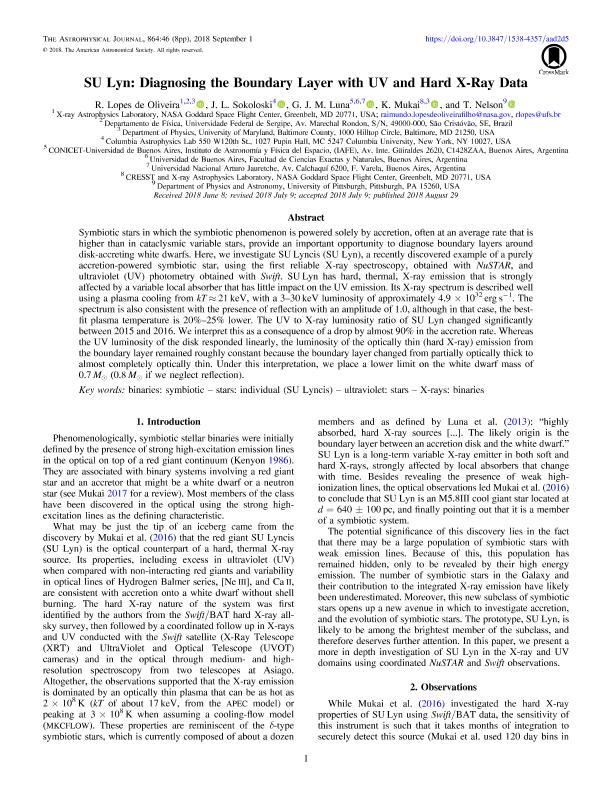Mostrar el registro sencillo del ítem
dc.contributor.author
Lopes de Oliveira, R.
dc.contributor.author
Sokoloski, j. L.
dc.contributor.author
Luna, Gerardo Juan Manuel

dc.contributor.author
Mukai, K.
dc.contributor.author
Nelson, T.
dc.date.available
2019-07-30T13:37:19Z
dc.date.issued
2018-08
dc.identifier.citation
Lopes de Oliveira, R.; Sokoloski, j. L.; Luna, Gerardo Juan Manuel; Mukai, K.; Nelson, T.; SU Lyn: Diagnosing the Boundary Layer with UV and Hard X-Ray Data; IOP Publishing; Astrophysical Journal; 864; 1; 8-2018; 1-8
dc.identifier.issn
0004-637X
dc.identifier.uri
http://hdl.handle.net/11336/80556
dc.description.abstract
Symbiotic stars in which the symbiotic phenomenon is powered solely by accretion, often at an average rate that is higher than in cataclysmic variable stars, provide an important opportunity to diagnose boundary layers around disk-Accreting white dwarfs. Here, we investigate SU Lyncis (SU Lyn), a recently discovered example of a purely accretion-powered symbiotic star, using the first reliable X-ray spectroscopy, obtained with NuSTAR, and ultraviolet (UV) photometry obtained with Swift. SU Lyn has hard, thermal, X-ray emission that is strongly affected by a variable local absorber that has little impact on the UV emission. Its X-ray spectrum is described well using a plasma cooling from kT ≈ 21 keV, with a 3-30 keV luminosity of approximately 4.9 × 1032 erg s-1. The spectrum is also consistent with the presence of reflection with an amplitude of 1.0, although in that case, the best-fit plasma temperature is 20%-25% lower. The UV to X-ray luminosity ratio of SU Lyn changed significantly between 2015 and 2016. We interpret this as a consequence of a drop by almost 90% in the accretion rate. Whereas the UV luminosity of the disk responded linearly, the luminosity of the optically thin (hard X-ray) emission from the boundary layer remained roughly constant because the boundary layer changed from partially optically thick to almost completely optically thin. Under this interpretation, we place a lower limit on the white dwarf mass of 0.7 M o (0.8 M o if we neglect reflection).
dc.format
application/pdf
dc.language.iso
eng
dc.publisher
IOP Publishing

dc.rights
info:eu-repo/semantics/openAccess
dc.rights.uri
https://creativecommons.org/licenses/by-nc-sa/2.5/ar/
dc.subject
Binaries: Symbiotic
dc.subject
Stars: Individual (Su Lyncis)
dc.subject
Ultraviolet: Stars
dc.subject
X-Rays: Binaries
dc.subject.classification
Astronomía

dc.subject.classification
Ciencias Físicas

dc.subject.classification
CIENCIAS NATURALES Y EXACTAS

dc.title
SU Lyn: Diagnosing the Boundary Layer with UV and Hard X-Ray Data
dc.type
info:eu-repo/semantics/article
dc.type
info:ar-repo/semantics/artículo
dc.type
info:eu-repo/semantics/publishedVersion
dc.date.updated
2019-07-29T14:51:48Z
dc.journal.volume
864
dc.journal.number
1
dc.journal.pagination
1-8
dc.journal.pais
Reino Unido

dc.journal.ciudad
Londres
dc.description.fil
Fil: Lopes de Oliveira, R.. National Aeronautics and Space Administration; Estados Unidos
dc.description.fil
Fil: Sokoloski, j. L.. Columbia University; Estados Unidos
dc.description.fil
Fil: Luna, Gerardo Juan Manuel. Consejo Nacional de Investigaciónes Científicas y Técnicas. Oficina de Coordinación Administrativa Ciudad Universitaria. Instituto de Astronomía y Física del Espacio. - Universidad de Buenos Aires. Facultad de Ciencias Exactas y Naturales. Instituto de Astronomía y Física del Espacio; Argentina
dc.description.fil
Fil: Mukai, K.. National Aeronautics and Space Administration; Estados Unidos
dc.description.fil
Fil: Nelson, T.. University of Pittsburgh at Johnstown; Estados Unidos
dc.journal.title
Astrophysical Journal

dc.relation.alternativeid
info:eu-repo/semantics/altIdentifier/url/http://iopscience.iop.org/article/10.3847/1538-4357/aad2d5/pdf
dc.relation.alternativeid
info:eu-repo/semantics/altIdentifier/doi/http://dx.doi.org/10.3847/1538-4357/aad2d5
Archivos asociados
